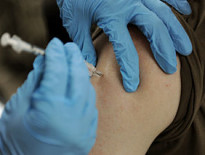
Image credit: CDC Public Health Image Library #5325
I love writing about vaccine-preventable diseases. I’ve written about measles, polio, and whooping cough. That’s because vaccines have become victims of their own success. Less than one hundred years after some of these vaccines were first used, they have led to the disappearance in the developed world of some of the most devastating infectious diseases. This extraordinary success has led to complacency or outright skepticism about vaccines among people whose grandparents knew the horrors of infectious diseases and rightly saw vaccines as godsends.
I’ve never seen a single case of tetanus or polio or measles, and I hope it stays that way. But it’s much more difficult for typical parents who have also never seen a case to understand the misery that these diseases caused not very long ago. Add to that some beautiful but idiotic celebrities who stoke fear about vaccine safety and a fraudulent study linking vaccines to autism and the result is a small but growing cadre of parents who refuse vaccines for their children.
Unfortunately, this summer diphtheria is in the spotlight.
Diphtheria is caused by a bacterium. It is transmitted from person to person through respiratory droplets by coughing and sneezing. A person can also contract diphtheria by handling an object, like a toy, that has been contaminated with the bacteria. It typically causes weakness, sore throat, fever, and enlarged lymph nodes in the neck. Two to three days later a thick coating builds up on the throat or nose, making it hard to breathe or swallow. The bacteria produce a toxin that is absorbed into the blood stream and can damage the heart, kidneys, and nerves. Diphtheria is treatable with antibiotics, but even with treatment 5% to 10% of patients die. Before antibiotics the disease was fatal in up to half of cases.
In 1921 there were 206,000 cases of diphtheria in the US, causing 1,520 deaths. When vaccination began in the 1920s case numbers quickly plummeted and there has not been a death in the US due to diphtheria for many years. There are scattered cases occasionally but between 2004 and 2008 no cases were recorded in the US.
Well, it’s time to celebrate, get complacent, and flirt with dangerous anti-vaccine propaganda!
In June a six year old boy contracted diphtheria in Spain and died. This was not someone who didn’t have access to healthcare. His parents had refused having him vaccinated. He was the first death due to diphtheria in Spain in 29 years. South Africa is currently facing an outbreak that has sickened fifteen and killed four.
Every day we make use of technology that would have been miraculous just a generation ago. It’s hard to remember that. I use Bluetooth to pair my smartphone to my car. I get turn-by-turn spoken directions using maps on Google’s servers. A flock of satellites allow my phone to figure out its location. It’s hard to keep track of the staggering number of technological breakthroughs at my command. It’s easy to believe that this is the natural order of things. It’s almost impossible to remember that the achievements that we rely on daily are the incremental accumulated work of generations, and that they could just as easily be undone.
Vaccine-preventable diseases are making a comeback because we’re forgetting what the world looked like without vaccines. If we don’t remind ourselves from the history books, we’ll be reminded by the news.
Learn more:
Diphtheria reported in Spain, 1st case in three decades (Outbreak News Today)
Boy Dies of Diphtheria in Spain, Parents Rejected Vaccine (AP)
South Africa diphtheria update: 15 cases and four deaths (Outbreak News Today)
About Diphtheria (Centers for Disease Control and Prevention)
Diphtheria vaccination (Centers for Disease Control and Prevention)
Measles Makes a Comeback (my post in 2014)
Polio Outbreak in Syria (my post in 2013)
Study Linking Vaccines to Autism not Just Wrong, Intentionally Fraudulent (my post in 2011 about the retraction of a fraudulent study)
California’s Whooping Cough Epidemic (my post in 2010 about pertussis)

